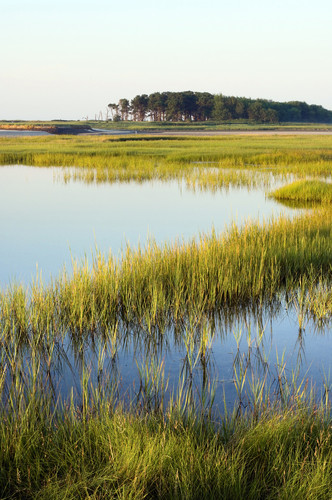The Wrack
The Wrack is the Wells Reserve blog, our collective logbook on the web.
The Wrack is the Wells Reserve blog, our collective logbook on the web.

The following was published in the Biddeford-Saco Journal Tribune Sunday edition, 9/21/2014.
With a too-short summer and the back-to-school fracas, anyone would be pardoned for missing the official Congressional resolution naming this coming week “National Estuaries Week,” the annual celebration of the places where rivers meet the sea.
Before you get too excited, please understand that the resolution is merely pending, and that estuaries don’t get the whole month. According to Congress, the entire 30 days of September have, in recent years, been reserved for Gospel Music Heritage, Bourbon Heritage, Prostate Cancer Awareness, Childhood Obesity, Honey, and even Self-Awareness. (And you thought our legislators didn’t do anything – shame on you.)
Resolved or not, 1/52nd of a year certainly seems like a worthy amount of time to devote to estuaries, those humble places of mud and marsh that do so much.
For instance: a 2008 NOAA study found that 50 percent of U.S. commercially harvested fish depend at some point on estuaries. Those landings generate more than $5 billion in revenues and support more than 1.6 million jobs. Thank you, salt marshes.
Recreation and tourism also get a big boost as hikers, birdwatchers, and other outdoor enthusiasts visit estuaries and spend their dollars in nearby towns. Visit the TripAdvisor.com page for the town of Wells and see for yourself – the #1 and #2-rated activities are the Rachel Carson National Wildlife Refuge and the Wells National Estuarine Research Reserve. (And #3 is “Laudholm Farm,” the locals-only name for the Wells Reserve.)
Of course, it’s not just about industry, jobs, or tourism. Healthy estuaries serve as natural filters for runoff, help protect our Maine beach communities against storm surges, and supply critical habitat for migrating birds and fish.
Come to think of it: from the dawn of history, river mouths and their flood plains have been the cradles of all the world’s civilizations. Hooray for estuaries – they’re not just swamps, are they?
NOAA’s national estuarine research reserve system, akin to a national parks system for estuaries, protects more than 1.3 million acres of these fragile, vital coastal lands and waters. In 2012, the 28 research reserves were the site of 281 intricate research projects and offered environmental education to more than 84,000 students from Pre-K through graduate school. In addition, the reserves conducted 331 training programs to aid coastal municipal leaders in dealing with water quality, habitat, and climate change challenges in their communities. From Alaska to Florida, California to Maine, estuaries are working for you.
We manage a mere 2,250 acres at the Wells National Estuarine Research Reserve, but as your local reserve, we invite you to come explore the history, the science, and the changing nature of this critical coastal site. Not just during this National Estuaries Week, but all year long.
Nik Charov is president of Laudholm Trust, the nonprofit partner of the Wells National Estuarine Research Reserve in Wells, Maine. His Sunday column, “Between Two Worlds,” ventures forth from the intersection of art and science, past and future, local and national. More at wellsreserve.org/twoworlds.